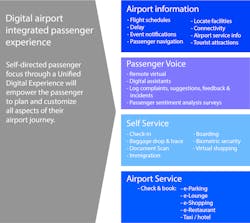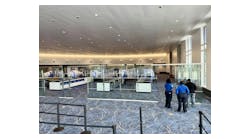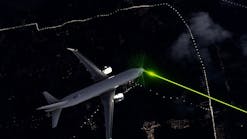Global passenger traffic is growing and airports are transforming how they do business to attract new airline routes, passengers and new forms of revenue. Competition to be the source and destination airport of choice is driving innovation to deliver a superior, differentiated passenger experience because everything is impacted by it. Technology, data sharing and collaboration will transform the airport experience for passengers and ultimately, provide a significant competitive advantage.
Digital technologies are the underlying solution enabler. Leading airports are already using technology to provide better passenger experience. Every touchpoint of passenger travel has the potential to improve passenger experience. Digital channels, digital media and self-service solutions are already a common expectation in many other service-based industries. Passengers want to be able to have information and options at their fingertips on their device of choice. The technology and implementation therein is already found in retail, banking and insurance industries; airports only need to leverage and apply what already exists. Can you imagine having to physically go to a financial institution to do your banking? In the future, passengers will feel the same way about airport experiences.
Future airports will have to have a personalized and self-directed passenger focus. This direct connection with the individual passenger and the subsequent convenience and empowerment for the passenger will make the digital airport their hub of choice, resulting in more repeat business and new growth. There are many examples of technology disruptors that have changed industries forever; the travel industry has been impacted by AirBnB, taxi services are being challenged by Uber, traditional cable companies are losing revenue to Netflix, even airlines who offer free Wifi on planes are now a deciding factor for people.
Conversely, service providers now have access to rich data and information that can allow them to quickly adjust offerings to provide the best outcomes for the business. Whether variables are cultural, related to time of day, demographic or situational, being able to use it as a seed for providing contextual and personalized services to the passengers. For example, digital advertising could be tailored for each flight arrival. Airport apps could inform passengers of services that are open and available to them. In short, being able to engage customers on their terms means they will have a better experience which will result in more passengers, more airlines, more market share and more retail revenue.
The passenger experience is relative to their best airport experience to date and it changes with each new experience. The best airport experience becomes the benchmark by which others are measured and technology is a key influencer. Airport experiences that fall short of that benchmark will create passenger dissatisfaction which may influence future travel decisions. And of course, through social media, a single negative post can create a significant negative impacts on revenue, brand and reputation.
Simply put, improving passenger experience leads to more passengers and ultimately, more revenue for the airport. According to 2014 DKMA analysis of publically available data from airports around the world, shows a significant link between high passenger satisfaction levels and increased non-aeronautical revenue. On average, a 20 percent improvement in passenger experience results in a $0.8 increased spend per passenger. The best airports have significantly invested in technology solutions to improve passenger experience. The most interesting example is Singapore’s Changi airport. Rated the best airport in the world for the last three years, the airport has implemented digital technologies to engage with their audience as well as capture passenger opinions (complaints/suggestions/feedback) at almost every touchpoint to help build the base of future improvements and strategies. The result: The airport services 50 million passengers every year and provides an experience that attracts customers not only looking to fly but also non-travelers showing up to only shop, eat and be entertained.
The salient point is that technology has enabled passengers to become pivotal players in the success of the airport business. Currently airports play a passive role in passengers' travel experience while airlines, business partners and travel agents are leading the passenger relationships. The new emerging scenario means airports need to better connect with passengers and provide integrated services across various passenger touchpoints. Airports will need to collaborate with airlines, travel agents, business partners and other service providers to provide the next generation of integrated passenger services.
Passengers are looking for quality services at airports that can enable convenient, informed and integrated travel experiences. Currently, passengers have multiple touch points when booking travel, exchanging currency, securing local transportation, finding flight information, accessing airport facilities/servicing, etc. In a true digital airport environment, the passenger will simply have a one-stop-shop service they can access from their own device. Many airports across globe are working toward this integrated travel experience by pursuing and implementing multiple innovative initiatives. These are also some of the highest ranked and successful airports in the world. While technology is critical to this outcome, there is no single silver bullet solution that can be consistently used across all airports. Each airport has different capabilities, resources, infrastructure and needs. Each airport requires its own unique solution to meet its success and growth objectives in order to meet passenger expectation and deliver a positive passenger experience.
The technology is available already. The key to success is having the right plan for the individual airport and having an experienced partner that build the right solution. Some things to consider include:
- Partnering with technology leaders/system integrators who are able to implement innovation and drive desired outcomes
- Consolidating digital airport initiatives under one strategy to avoid costly and inefficient solution siloes and instead leverage operational insight
- Developing an organization change management framework to ensure agile and clear processes
- Establish incremental iterations with the clear KPIs to measure the improvements
While technologies are available, most airports haven’t realized the necessity of using digital technologies and exploring new business models. Now is the time to develop a “digital airport” strategy before it becomes too late. As IATA says, 80 percent of airports are expected to have self-service airport processes by 2020 to enable fast travel.
Developing and implementing a “Digital Airport Strategy” is a considerable task that must take into account where you are and where you need to be. Simply initiating new technologies without a clear plan will not work. Airports must work collaboratively within their own organization, airlines and retailers to develop the digital passenger experience that is available to the passenger before they arrive at the airport from their homes or connecting flight until they arrive at their destinations.
Industry consultants and designers develop customer experience journey and identify best technology to get there and evolve into the next iteration.
Vasuki Upadhya is a lead architect for the Global Airport Practice within Wipro Limited. He has 20 years of IT industry experience in IT strategy, consulting, enterprise architecture and innovation. He has been engaged on strategic and complex programs with global major industries like Oil and gas, utilities, airports, ports, mining and smart cities. Vasuki is responsible for defining solutions for large complex programs and engagements along with designing and developing next-generation technology solutions.





